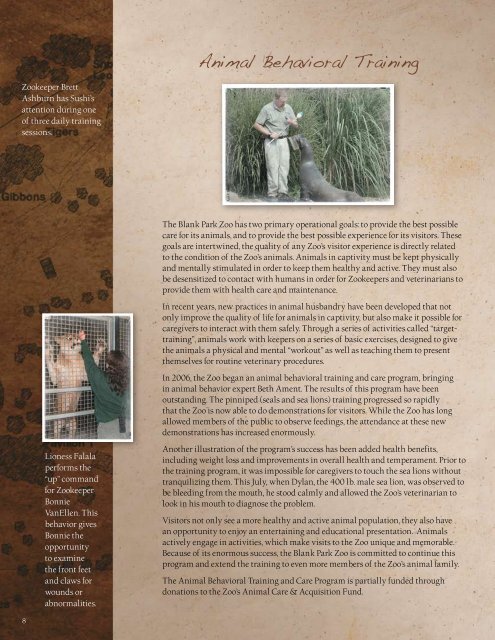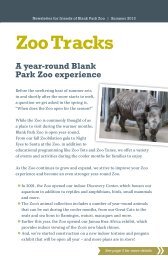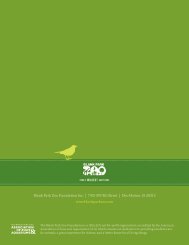Blank Park Zoo Foundation - Happy Holidays from Blank Park Zoo
Blank Park Zoo Foundation - Happy Holidays from Blank Park Zoo
Blank Park Zoo Foundation - Happy Holidays from Blank Park Zoo
- No tags were found...
Create successful ePaper yourself
Turn your PDF publications into a flip-book with our unique Google optimized e-Paper software.
<strong>Zoo</strong> StaffRyan P. BickelAnimal Behavioral Training<strong>Zoo</strong>keeper BrettAshburn has Sushi’sattention during oneof three daily trainingsessions.The <strong>Blank</strong> <strong>Park</strong> <strong>Zoo</strong> has two primary operational goals: to provide the best possiblecare for its animals, and to provide the best possible experience for its visitors. Thesegoals are intertwined, the quality of any <strong>Zoo</strong>’s visitor experience is directly relatedto the condition of the <strong>Zoo</strong>’s animals. Animals in captivity must be kept physicallyand mentally stimulated in order to keep them healthy and active. They must alsobe desensitized to contact with humans in order for <strong>Zoo</strong>keepers and veterinarians toprovide them with health care and maintenance.In recent years, new practices in animal husbandry have been developed that notonly improve the quality of life for animals in captivity, but also make it possible forcaregivers to interact with them safely. Through a series of activities called “targettraining”,animals work with keepers on a series of basic exercises, designed to givethe animals a physical and mental “workout” as well as teaching them to presentthemselves for routine veterinary procedures.Lioness Falalaperforms the“up” commandfor <strong>Zoo</strong>keeperBonnieVanEllen. Thisbehavior givesBonnie theopportunityto examinethe front feetand claws forwounds orabnormalities.In 2006, the <strong>Zoo</strong> began an animal behavioral training and care program, bringingin animal behavior expert Beth Ament. The results of this program have beenoutstanding. The pinniped (seals and sea lions) training progressed so rapidlythat the <strong>Zoo</strong> is now able to do demonstrations for visitors. While the <strong>Zoo</strong> has longallowed members of the public to observe feedings, the attendance at these newdemonstrations has increased enormously.Another illustration of the program’s success has been added health benefits,including weight loss and improvements in overall health and temperament. Prior tothe training program, it was impossible for caregivers to touch the sea lions withouttranquilizing them. This July, when Dylan, the 400 lb. male sea lion, was observed tobe bleeding <strong>from</strong> the mouth, he stood calmly and allowed the <strong>Zoo</strong>’s veterinarian tolook in his mouth to diagnose the problem.Visitors not only see a more healthy and active animal population, they also havean opportunity to enjoy an entertaining and educational presentation. Animalsactively engage in activities, which make visits to the <strong>Zoo</strong> unique and memorable.Because of its enormous success, the <strong>Blank</strong> <strong>Park</strong> <strong>Zoo</strong> is committed to continue thisprogram and extend the training to even more members of the <strong>Zoo</strong>’s animal family.The Animal Behavioral Training and Care Program is partially funded throughdonations to the <strong>Zoo</strong>’s Animal Care & Acquisition Fund.







